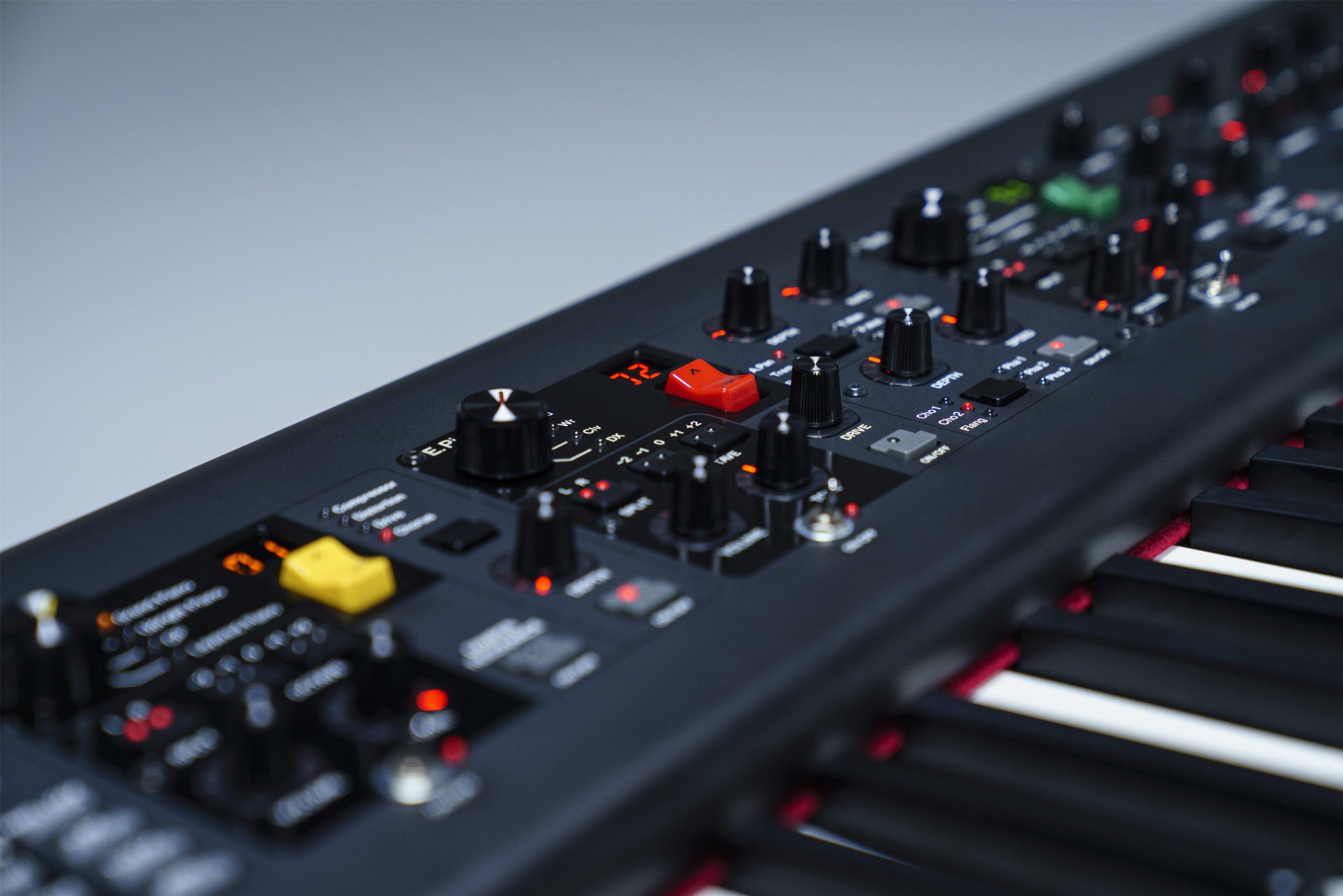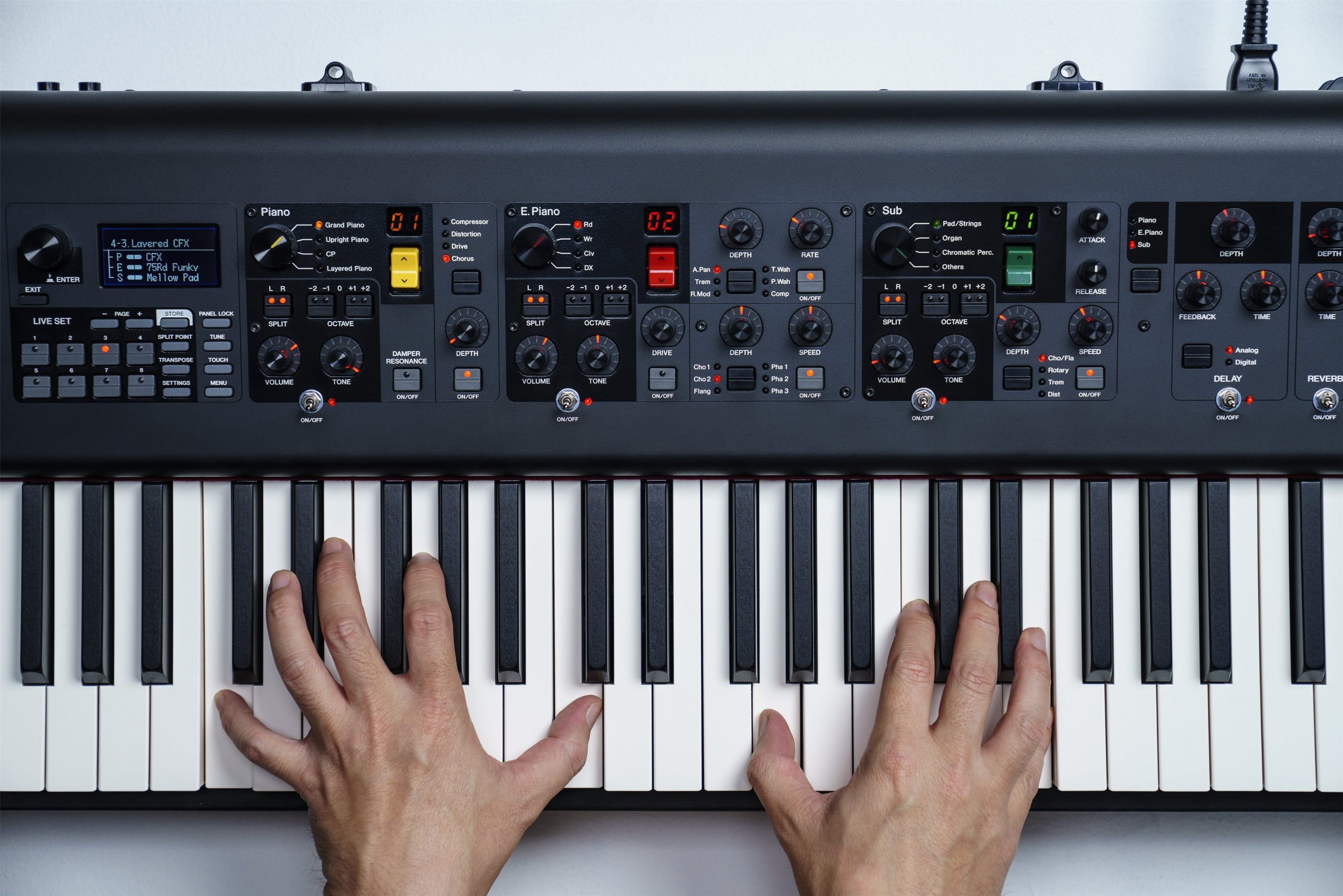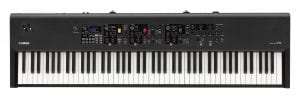The Yamaha CP88 and CP73 belong to the series of stage pianos from this flagship brand. They have a number of unique and excellent specifications, that is good enough to valor your stage performances. We would also love to appreciate the dedicated real-time controls on these pianos that make them stay on top of other pianos both from Yamaha and its rivals. Let us discuss the inherent features and the specifications of the Yamaha CP88 here.
Table of Contents
Yamaha CP88 Piano Review 2024
What’s Best in Yamaha CP88?
- The Keyboard comes with a complete library of 57 voices.
- The piano features a solid aluminum body with plastic construction and thus is durable and lightweight.
- Simple ‘What you see is what you get design’ without complex controls
- Well-crafted wooden keyboard with plastic body
- Number of sound design options in its advanced mode
What’s Lacking in Yamaha CP88?
- The Yamaha CP88 does not feature the virtual resonance modeling technology, thus users may get detailed simulations of pedal noise and string resonance.
- Does not have built-in speakers
- No internal storage to store songs for practice
About the Yamaha CP88
| Number of Keys | 88 |
| Piano Sound | AWM2 Sample Playback Engine |
| Weight | 41 lbs |
| Keyboard Type | Graded Hammer Triple Sensor |
| Tunes | 57 |
| Polyphony | 128 |
I would like to describe this piano in three simple words ‘portable’, ‘easy to use and the ‘best quality sound’. The CP88 is the evolution in the range of stage pianos that couples the ease of use of modern-day pianos with the electrifying sounds of a grand acoustic piano. The CP88 seems to have a perfect blend of everything, electric piano sounds, acoustic piano sounds, responsive touch, and an intuitive one-on-one user interface. The century-plus years of experience and Yamaha’s craftsmanship are shown truly in this piano and you will also agree with me at the end of this review.
Related:- Yamaha P125 Digital Piano Review
Top Features and Specifications of CP88
- Natural wood graded hammer triple sensor keyboard with ebony and ivory key tops
- 128 polyphony sounds with AWM2 tone generator
- 57 tunes that include 10 pianos, 14 electric pianos, and 33 sub voices.
- Excellent sound effects that include master delay, reverb, and other real-time controls.
- Social sound sharing feature grants access to thousands of free sounds.
- Graphical LCD screen
- Seamless sound switching features
- MIDI interface for audio control and recording
- FC3A piano-style sustain pedal with half-pedaling feature
Exterior Design on the Yamaha CP88

The Yamaha CP88 has excellent build quality and is in fact build tough to match the needs of the giggling musicians who are always on the move. After all who would want to instill damage on their pianos during transit? The CP series from Yamaha combines the toughness of aluminum chassis and the durability of solid metal, with the lightweight nature of plastic.
This 88 keys full weight keyboard weighs 41 pounds and its front panel looks arguably complex. There are innumerable ways you can try switching between its controls to create some unique masterpieces. The piano has the best set of buttons and knobs and will please the tactile sense of the pianist to deliver some beautiful classic synthesizers.
The toggle switches, or the tiny metal switches that serve as on and off toggles for the instrument, add to the classic feel of the CP88. The piano controls are distinctly divided into three different parts to differentiate the piano, electric piano, and other instruments sections. With this array of controls, there is less need to use the manual and memorize the multi-function controls.
The pitch and the mod controls stick lie on the upper left side of the piano and are arranged at an angle, to help with ergonomics. Its LCD display has an excellent contrast level and is capable of displaying a good amount of information at a single time.
In short, the keyboard looks elegant, and professional, and has labeled controls that are pretty simple to use. for beginners who wish an uncluttered interface and easy-to-use controls, the CP88 should be their best bet.
Check out: Yamaha DGX-660 Digital Piano Review
Sound Quality of Yamaha CP88
The Yamaha CP88 combines the power of 100 years of craftsmanship and 45 years of synthesizer innovation. People love this piano for its realistic touch and intuitive interface. Its sounds comprise tunes from a grand piano, electric piano, and upright piano along with other musical instruments for creating music of the different genres.
It sounds like more like three premium grand pianos namely the Bosendorfer Imperial 290, CFX grand, and S700 concert grand. If you are an experienced pianist then you could deliver crisp highs, excellent mid-range, and sparkling bass with a propounding range and volume to power a complete symphony orchestra. This piano has the capability to voice through dense arrangements and can also stay delicate and expressive in sparse musical settings, all credits to the master artisans who are behind the construction of the CP88.
As this piano sounds more like the Bosendorfer Imperial, it carries with it its characteristic Viennese sounds, that is symbolized by rich overtones, warm bass, and singing treble. The imperial bass resonated with every single keystroke and at all frequencies. All the sounds on the CP88 are sample-based purely with no modeling.
You can check out this YouTube Video to know how good the CP88 sounds.
Sound Effects and Controls

By turning the rotary selector, you can switch between the four sound categories namely, CP, grand, layers, and upright. You can also switch between presets by tuning its rocker switch. The volume controls are simple and easy to access, as they are laid simple without much clutter. It also enables you to make quick mixing between the play.
The built-in tilt EQ helps you to alter the crispness of the song as you play. The damper resonance switch helps in titular simulation. The piano section features four major effects such as chorus effect, compressor, distortion, and overdrive effect, and all these together add more life to the song that one plays.
Most of the sounds from this piano are excellent and practical and you can use the dedicated FX of all three sections with any sound that is stored in the library. This is done with the advanced mode option, one of the best features of the CP88.
Note: Yamaha CP88 features in our lists of best digital pianos under $3000 and best digital pianos under $5000.
Keys of Yamaha CP88

The Keys of the CP88 are worth mentioning as they feature a natural wood-graded hammer action. The feel of its keypresses mimics the original acoustic piano as real wood lies below the plastic shell of the keys. The ebony and the ivory key tops ensure less slipping of fingers during play. The white keys of the piano have a solid wood core with minimal plastic and the black keys are entirely made of plastics.
The keys allow the pianist to play a variety of genres with its splitting and layering options. As there are controls for everything in this piano, splitting, and layering are also made pretty easy. For the layering effect, you simply have to activate each of the sections to get a layered effect, and also control the volume with the knobs concurrently.
To achieve the split mode, define a split point at the onboard menu and you will be able to play different tones on both the left and the right side of the split point.
The Yamaha CP88 Connectivity Features
The CP88 features some of the best and most extensive connectivity options.

- It features a stereo output jack to help monitor and listen to your own sounds during practice.
- There are two output jacks to connect with amplifiers or speakers
- The XLR outputs can be used to connect with the house mixers without mandating the need for a DI box.
- The two input jacks allow the user to integrate external sound modules through.
- There are two-foot controller jacks to assign expression pedals. Be sure to use a compatible pedal to control all parameters.
- The two-footswitch jacks connect with the sustain and assignable pedal. The sustain pedal supports half-pedaling as well.
- The 5-pin MIDI ports help in controlling all the external sound modules and the legacy gear.
- There is also a slot to connect with the USB flash drive to save all device data.
The Accessories you get with the Yamaha CP88
The CP88 comes with an FC3A sustain pedal that feels sturdy and solid with nil polarity issues. The piano doesn’t come with a music stand, if you want a music rest to put your music sheets conveniently in from of you, you can buy and use it separately.
You can also buy an expression pedal if you want to make some modulations when both your hands are busy on the keyboard. Up to two modulation pedals are supported for quality music. Also, ensure to invest in a durable and credible case, as you may have to transport this stage piano often.
Like other pianos from Yamaha, the CP88 doesn’t have a built-in speaker, so you may have to invest in quality headphones or an external amplification system to get your tunes really audible.
Related:-
Wrapping Up
The Yamaha CP88 as an instrument looks great and sounds extraordinary. You can use this instrument easily without the need of referring to the manual. The WYSIWYG approach is welcomed and is good enough for beginners and amateur pianists. It is capable of creating some terrific sounds that are authentic and responsive. Its samples are extraordinary and when combined with its keys, are capable of generating great sounds. Its simple yet elegant and powerful nature gets people to embrace it wholeheartedly.

